Physical Address
304 North Cardinal St.
Dorchester Center, MA 02124
Left ventricular (LV) filling results from active relaxation and diastolic chamber compliance, and LV diastolic dysfunction (DD) is the result of impaired LV relaxation and increased LV chamber stiffness with increased LV filling pressures (FP). Until the 1970s, these two aspects of diastolic function were assessed by cardiac catheterization measurements. The isovolumic relaxation rate of pressure decline (tau) as a measure of active relaxation and the LV diastolic pressure–volume relationship as a measure of compliance are key parameters of LV diastolic function. , However, catheterization is invasive, not easily accessible, and unsuitable for routine assessment of diastolic function. In addition, LV diastolic function is modified by left atrial (LA) function, right ventricular (RV) function, torsion, arrhythmia, and pericardium ( Fig. 6.1 ). In the clinical setting, echocardiography is the best method of assessment for these confounding functional parameters.
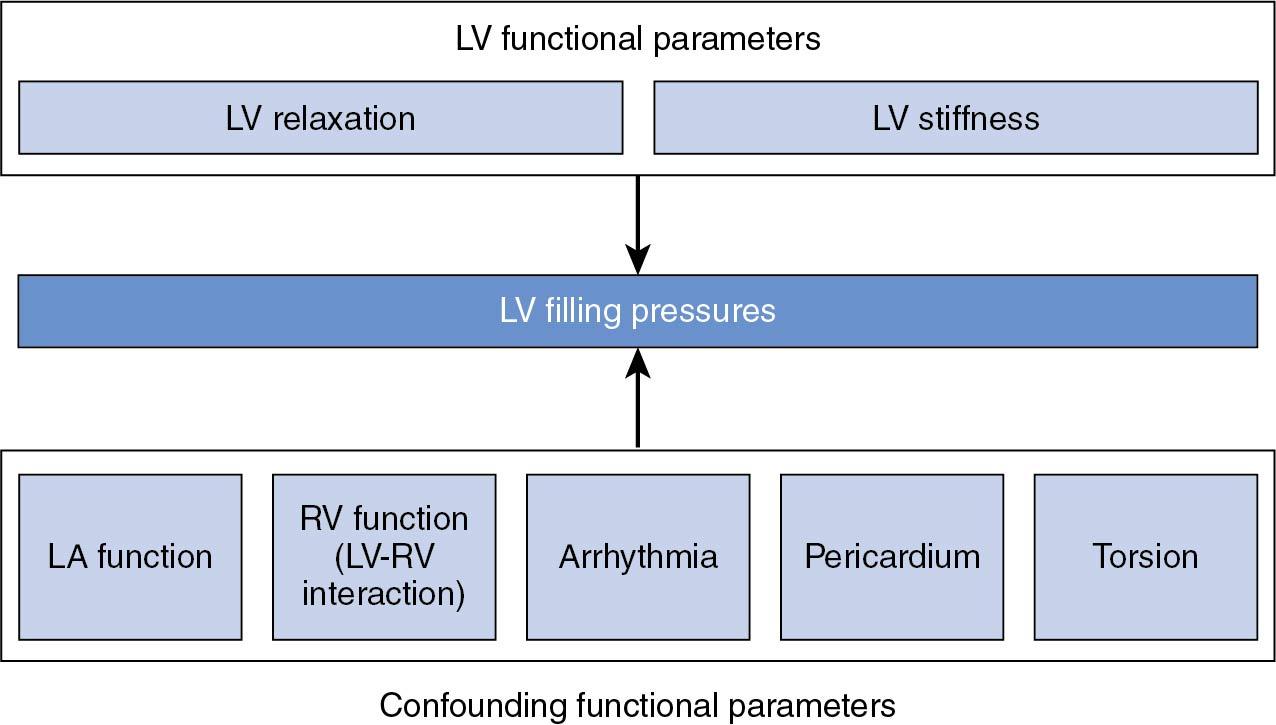
Kitabatake et al were the first to show the clinical significance of LV inflow velocities using pulsed Doppler echocardiography to estimate LV diastolic function. Indeed, many researchers have tried to identify LVFP and DD in the clinical setting using echocardiography. Recently, new indices, including strain imaging, have been developed and add value to the estimation of LVFP and diastolic function.
Evaluation of LV diastolic function is challenging, and a number of different noninvasive approaches have been proposed. , In 2009, the American Society of Echocardiography (ASE) and European Association of Cardiovascular Imaging (EACVI) guidelines for diastolic function assessment included many two-dimensional (2D) and Doppler parameters to grade diastolic dysfunction and estimate LVFP. , However, the number of parameters were thought to complicate the assessment of LV diastolic function, so in 2016, the ASE/EACVI guidelines were updated to simplify the approach and increase the utility of the guidelines in the clinical setting. , In 2017, large multicenter American and European studies confirmed the validity of the 2016 recommendations for diagnosis of heart failure (HF) using invasive pressure measurement as a reference method. , The recommendations have also been validated by several studies showing their predictive value for outcomes. Moreover, the recent guidelines have shown to be reproducible by both fellows and established cardiologists.
Several cardiovascular risk factors, including arterial hypertension, diabetes mellitus, obesity, or sleep apnea syndrome, are often found at a preclinical stage of diastolic dysfunction. Because the progression from normal function to diastolic dysfunction is continuous with aging, it is difficult to determine what criteria should be used for diastolic dysfunction. In the first algorithm of the recent recommendations, in a patient with no clinical heart disease, the presence of diastolic dysfunction was considered when >50% of the parameters of e′, E/e′, LA volume index, and peak tricuspid regurgitation (TR) velocity were abnormal ( Fig. 6.2 A). When there is a clinical suspicion of myocardial pathology with a high likelihood of diastolic dysfunction, including reduced ejection fraction (EF), hypertensive heart disease, cardiomyopathy (i.e., amyloidosis), coronary artery disease (CAD) with wall motion abnormalities, or abnormal Doppler signals, the patient is considered likely to have diastolic dysfunction and moves to Fig. 6.2 B. In addition, there are special populations to which that these algorithms should not be applied; different criteria should be used ( Table 6.1 ).
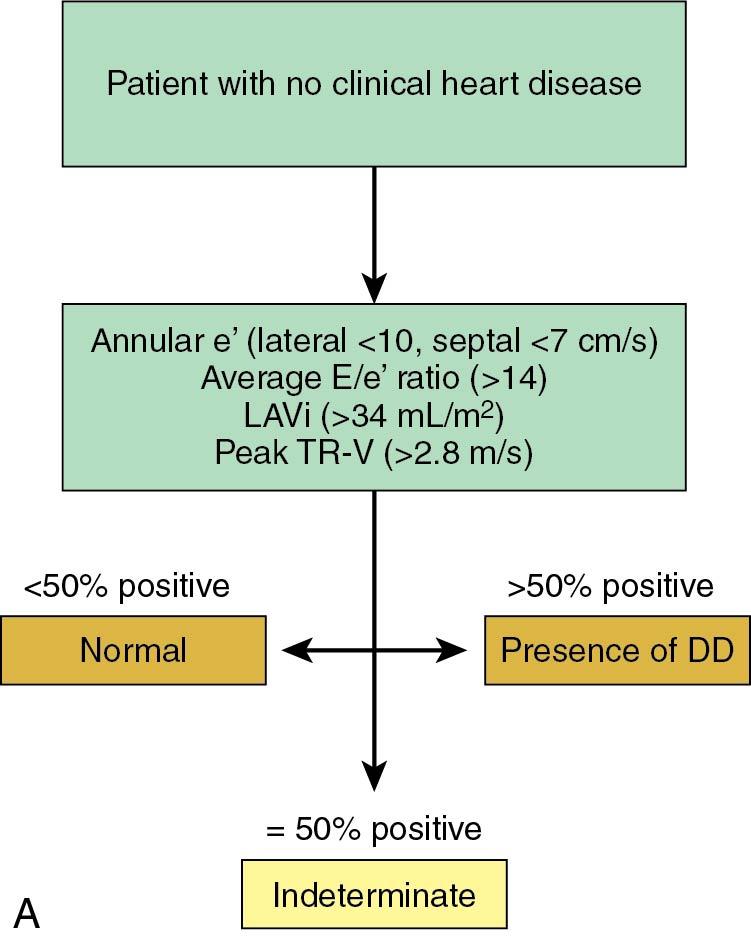
| There are cases when it is impossible to apply the algorithm. Specific cardiovascular diseases include hypertrophic cardiomyopathy, restrictive cardiomyopathy, valvular heart disease, heart transplantation, atrial fibrillation, atrioventricular block and pacing, and so on. Different algorithms for each disease should be applied. |
| Special Populations in Applying Different Algorithms |
|
However, the new ASE/EACVI recommendations have the disadvantage of limited sensitivity and an “epidemic” of patients classed as having indeterminate filling pressure. In a retrospective study that applied this algorithm in 1000 individuals ≥45 years of age to assess the prevalence of diastolic dysfunction in updated recommendations, only 1% had diastolic dysfunction with the 2016 recommendations, but 38% had diastolic dysfunction with the 2009 recommendations. On the other hand, there were limitations in this previous study because the guidelines were incorrectly applied as clinical, two-dimensional data, and specific Doppler signals were not considered. Use of the 2016 recommendations led to a classification as indeterminate in 15%—these diagnoses being made in algorithm 1 when only two of four measurements are positive ( Fig. 6.3 ) and in algorithm 2 when there are missing data for the intermediate group (e.g., one positive and one negative and a nondiagnostic TR signal) ( Fig. 6.4 ).
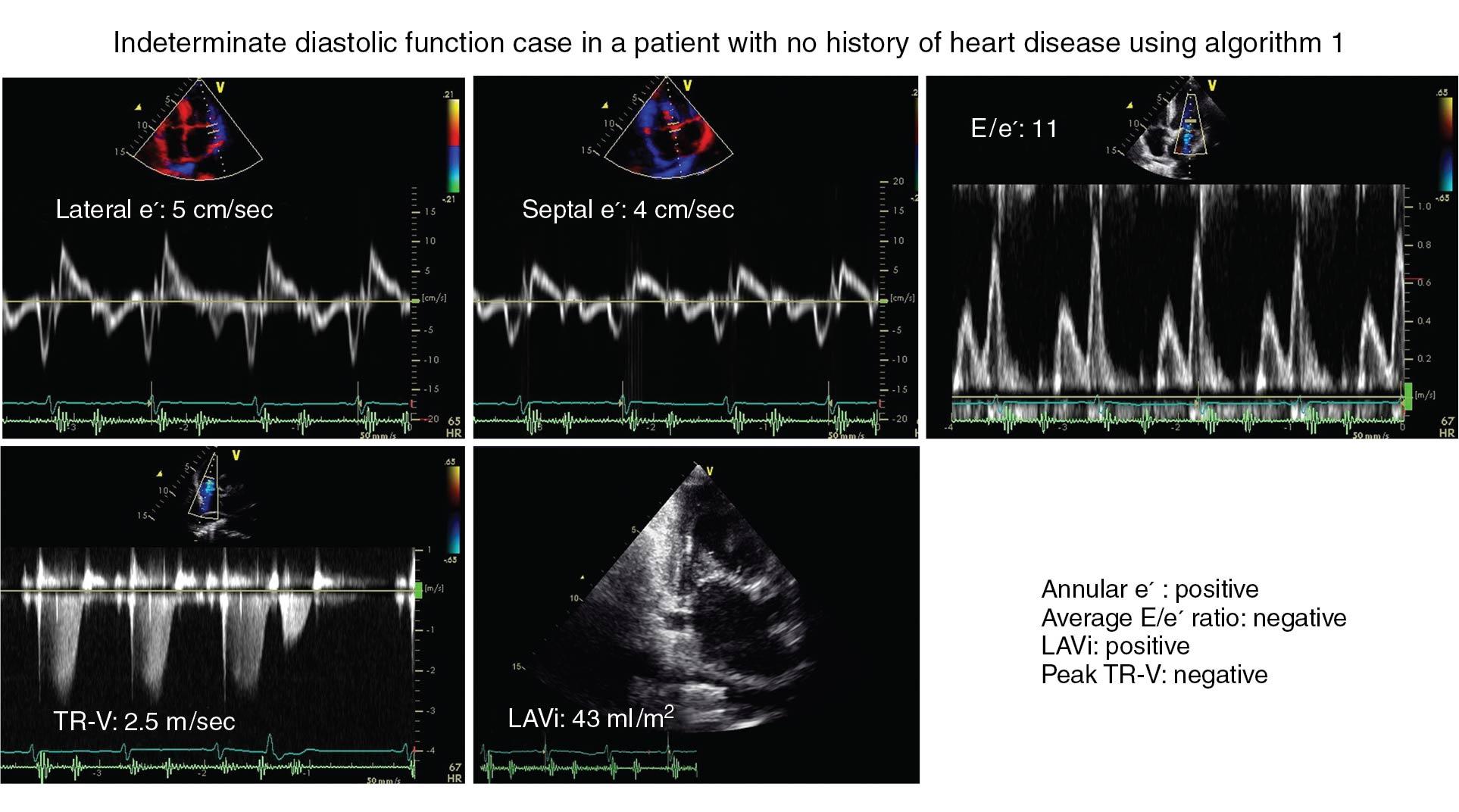
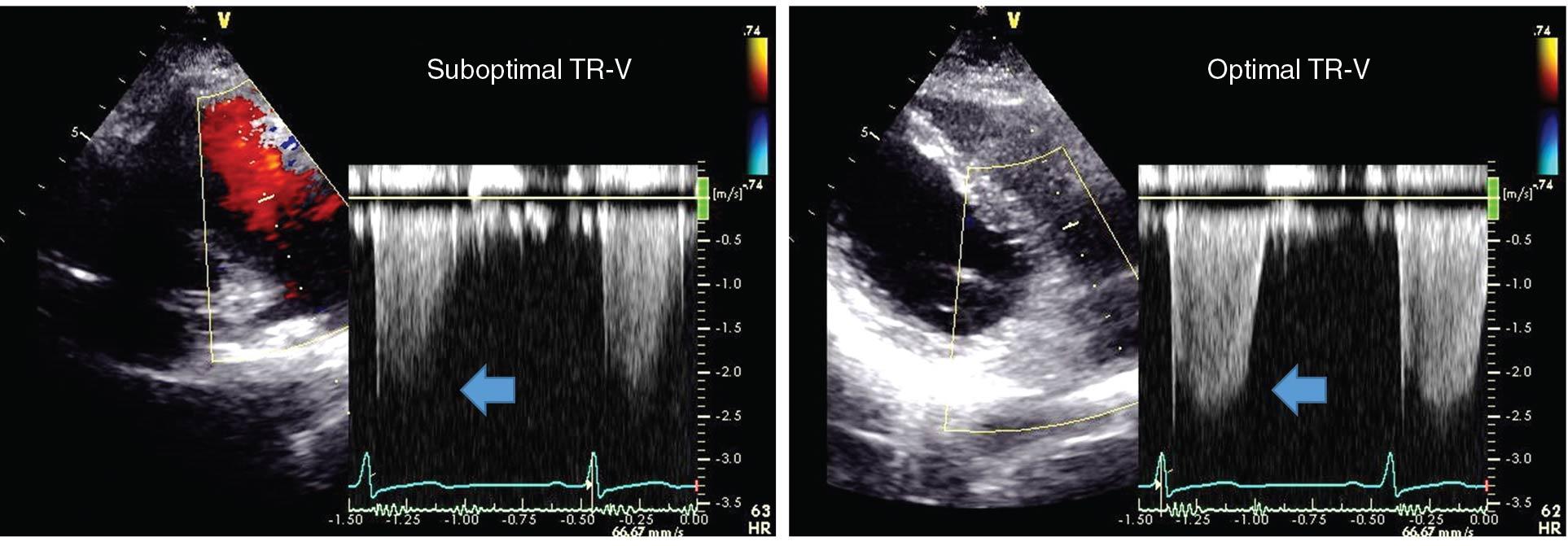
The limitations of the updated guidelines algorithm have led to the use of a variety of supplementary methods to determine the presence or absence of diastolic dysfunction and estimate LVFP in indeterminate cases. Measuring strain by 2D speckle-tracking echocardiography is a potential supplementary method of assessing DD and estimating LVFP ( Central Illustration 6.1 ). In this evaluation, it is prudent to check complicating factors such as arrhythmia, valvular disease, cardiomyopathy, pericardial disease, and right-sided heart disease, all of which can influence strain measurements.
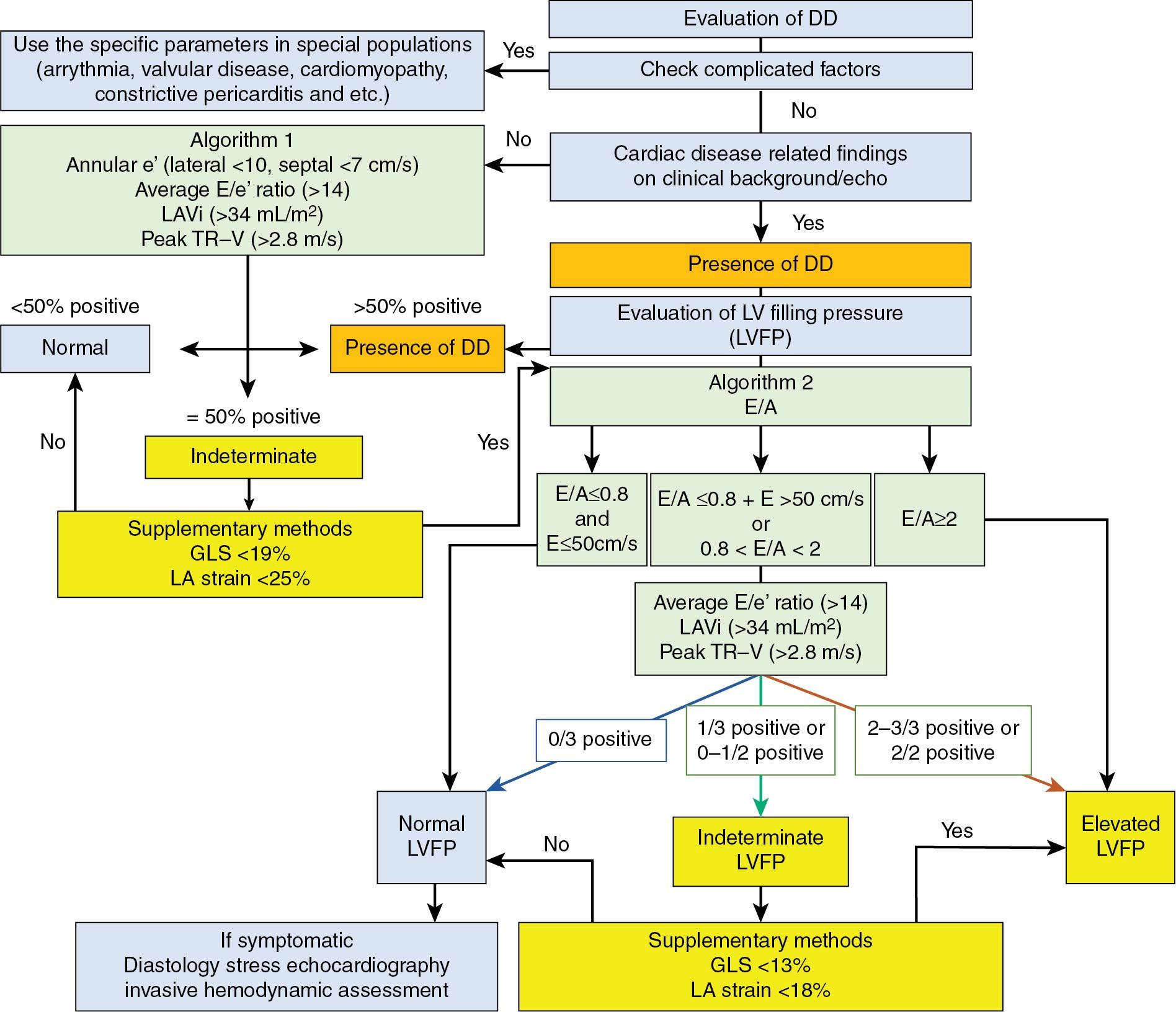
Some patients with normal LVEF at risk of progressing to HF have subclinical LV systolic dysfunction. The correlation between LV relaxation (tau) and LV contractility supports the notion that diastolic function (the ability of the left ventricle to fill adequately after LV systole at an end-diastolic pressure <15 mmHg) is influenced by systolic function.
Global longitudinal strain (GLS) based on the speckle-tracking method can be used for the objective and reliable assessment of systolic function, including subclinical dysfunction. Generally, patients with heart failure with preserved ejection fraction (HFpEF) usually have abnormally depressed GLS, and GLS can be used as a supplementary test when echocardiographic indices of diastolic function are indeterminate or when the presence of heart disease is unclear. For example, reduced GLS provides support for heart disease as the underlying cause of symptoms in patients with shortness of breath. A GLS <19% has been proposed as a marker of likely LV diastolic dysfunction based on the meta-analysis data.
Use of GLS to understand the pretest probability of LV dysfunction differs from the proposed value for the recognition of elevated LV filling pressure, which has been proposed as a GLS <13%. A more specific approach, based on knowledge about the association between GLS and tau, showed the E/GLS ratio to estimate LV filling pressures with 72% sensitivity and 88% specificity compared with invasive hemodynamic evaluation. This parameter showed better accuracy than the E/A ratio and even the E/e′ ratio ( Fig. 6.5 ). Nonetheless, because GLS is a systolic measurement, E/GLS is considered by some to be a controversial parameter.
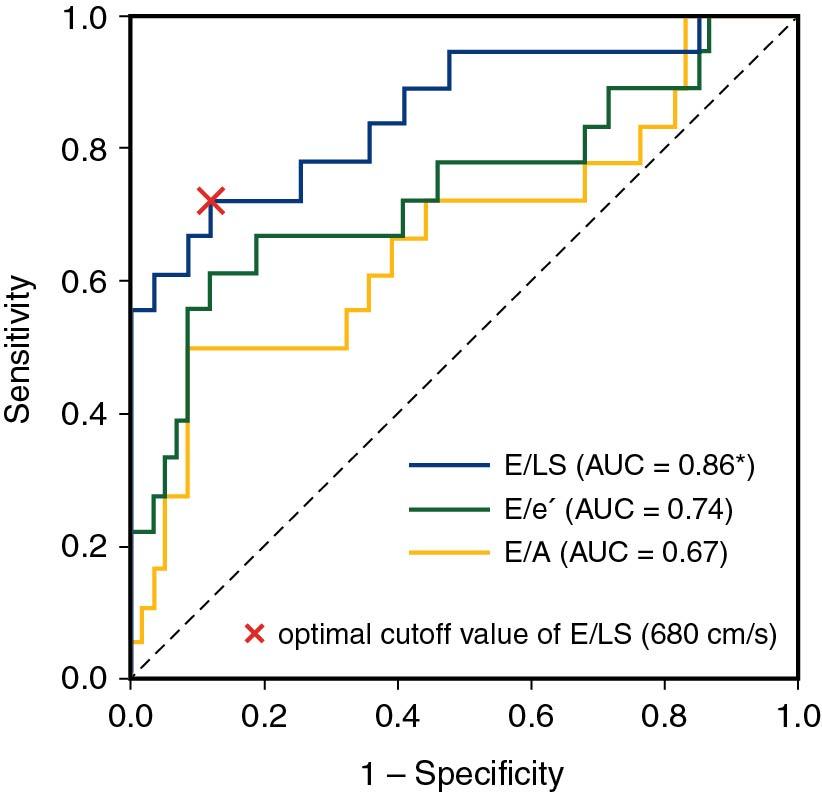
Human studies reported significant associations of global LV strain rate during the isovolumic relaxation period (SR IVR ) and SR E with the SERCA2a gene and protein expression. Indeed, SR IVR and SR during early diastole (SR E ) also have a significant association with tau ( Fig. 6.6 ). SR IVR is analogous to e′ (uninfluenced by mitral annular calcification) and is theoretically a suitable marker to estimate LV relaxation because relaxation and the resulting LV pressure decay occur during the IVR period. Thus the E/SR IVR ratio can be useful for accurate assessment of LVFP and to predict outcomes in several disease states. However, accurate measurement of strain rate during the relatively short duration requires a satisfactory image with high temporal resolution, which is sometimes difficult to obtain during a clinical examination. Although there are promising results reported by several investigators, the technical challenges and the variability in strain rate measurements on the basis of ultrasound images and the software used for analysis limit clinical application of these parameters.
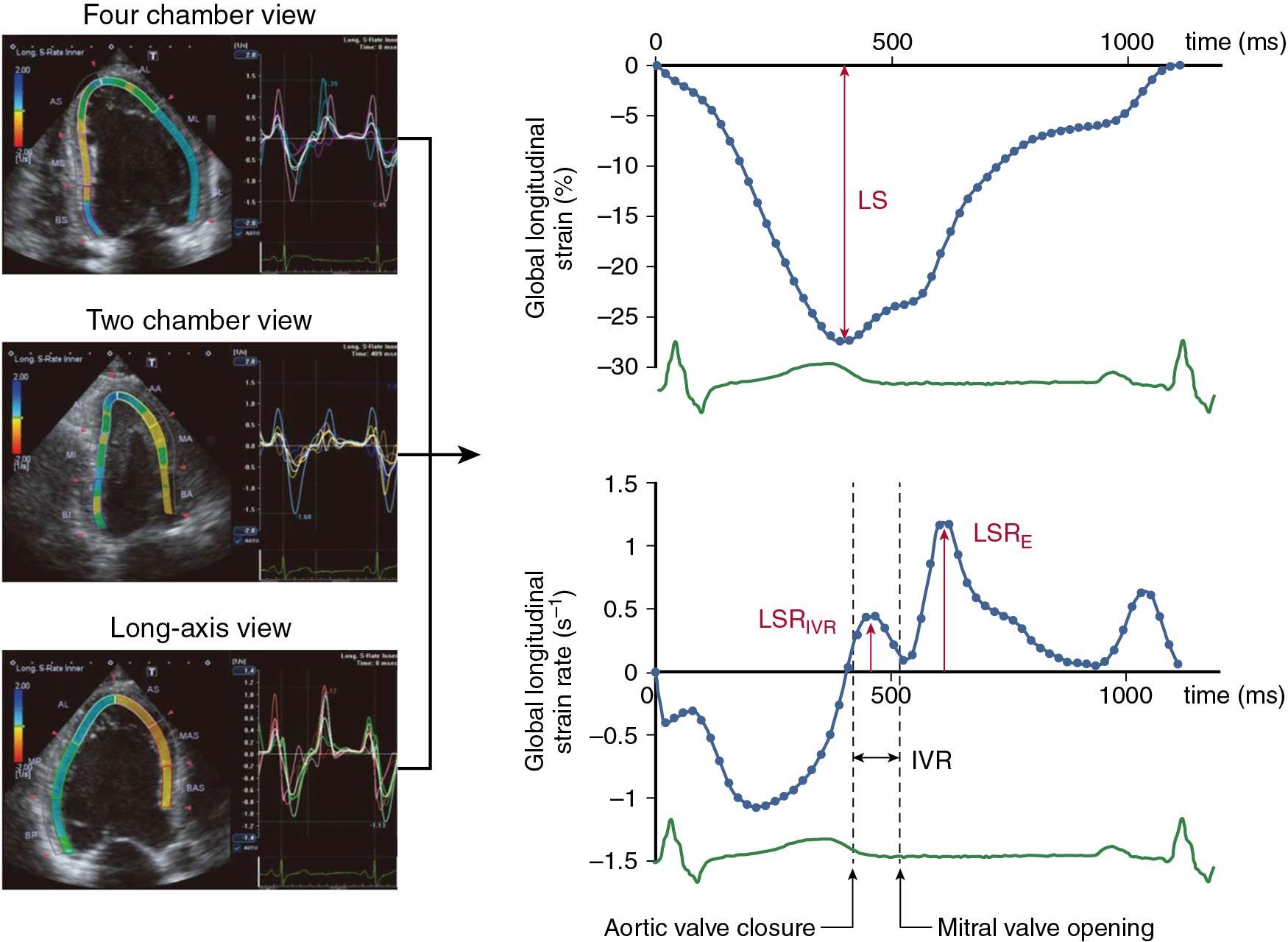
LA volume reflects the chronic effect of LVFP over time and is an important marker of diastolic dysfunction and LA structural remodeling. LA function consists of three components (reservoir, conduit, and booster pump function) and contributes to LV filling ( Fig. 6.7 ). , LA reservoir function is influenced by atrial compliance during ventricular systole and is related to LA stiffness during ventricular diastole. LA relaxation is first impaired, and subsequently LA filling is influenced by LV longitudinal systolic dysfunction and LA subendocardial fibrosis. LA diastolic stiffness is gradually increased; thus, LA remodeling can be used as a marker of LV diastolic dysfunction. These findings suggest that LV myocardial contraction and relaxation and LA stretch are simultaneously impaired in elderly individuals or asymptomatic patients with cardiovascular risk factors. Moreover, in 481 normal-weight healthy participants, decreases in LA reservoir and conduit strain were the earliest markers of age-related cardiac remodeling. Because of these phenomena, many investigators focused on LA reservoir function in previous papers to assess the clinical utility of LA strain.
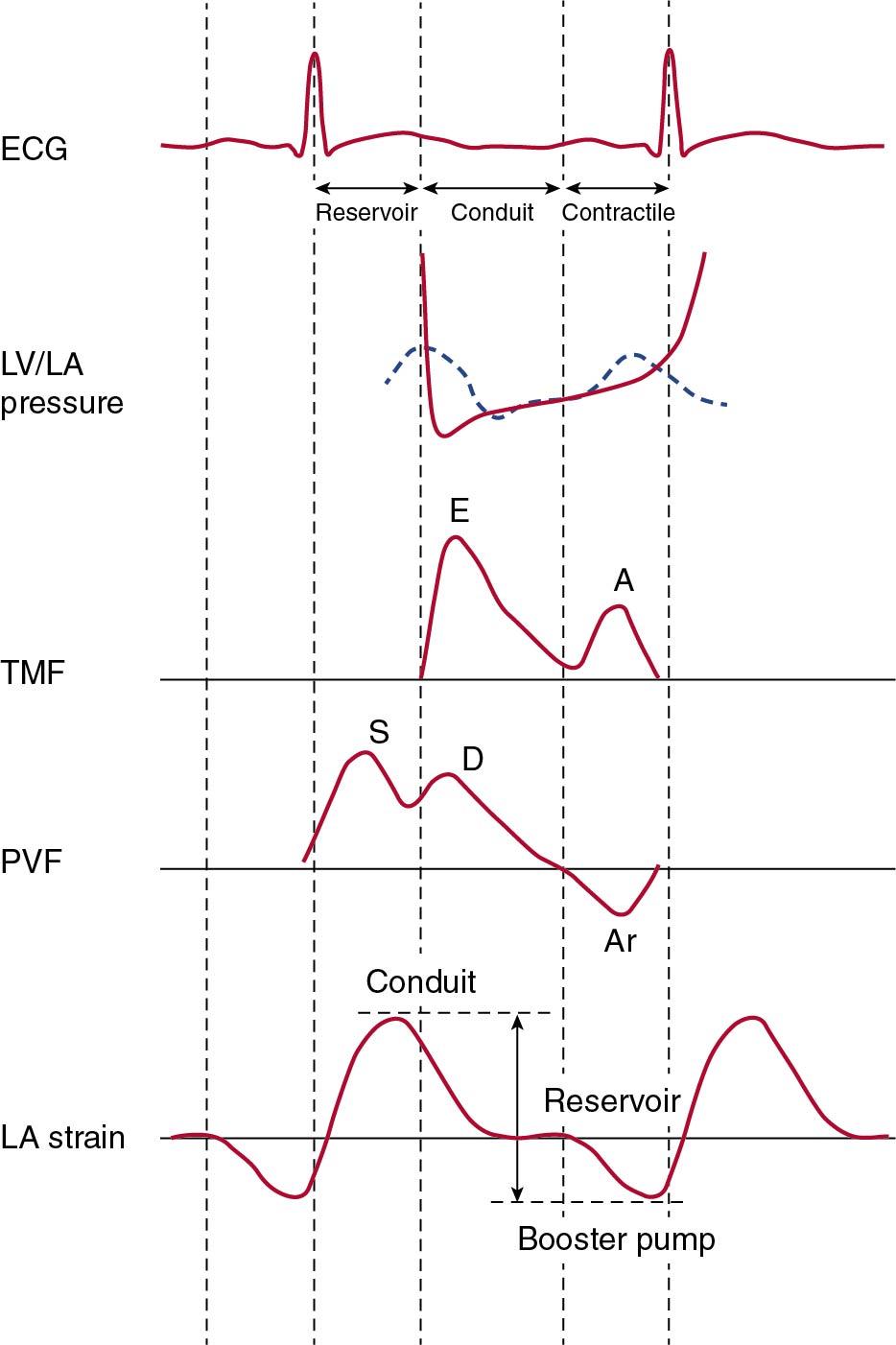
Some technical tips are important when LA strain is evaluated by echocardiography. Analysis of LA strain requires a good image quality with a frame rate >60 frames/s to provide accurate tracking. There are two gating types (P wave or QRS complex) for the LA analysis ( Fig. 6.8 ), which have different initial lengths for calculation of LA strain. Although some investigators have suggested that the gating can be on the P wave for patients in sinus rhythm and the QRS complex for those in atrial fibrillation (AF), this provides unnecessary inconsistency in LA reservoir strain (LARS). Perhaps a better approach is to use P-wave triggering if the primary interest is contractile strain. Global LA strain generally expressed as the average strain of all LA segments in the apical two- and four-chamber views can be calculated from a single apical four-chamber view. It is important that images for LA strain measurement are not foreshortened and include the maximum LA volume.
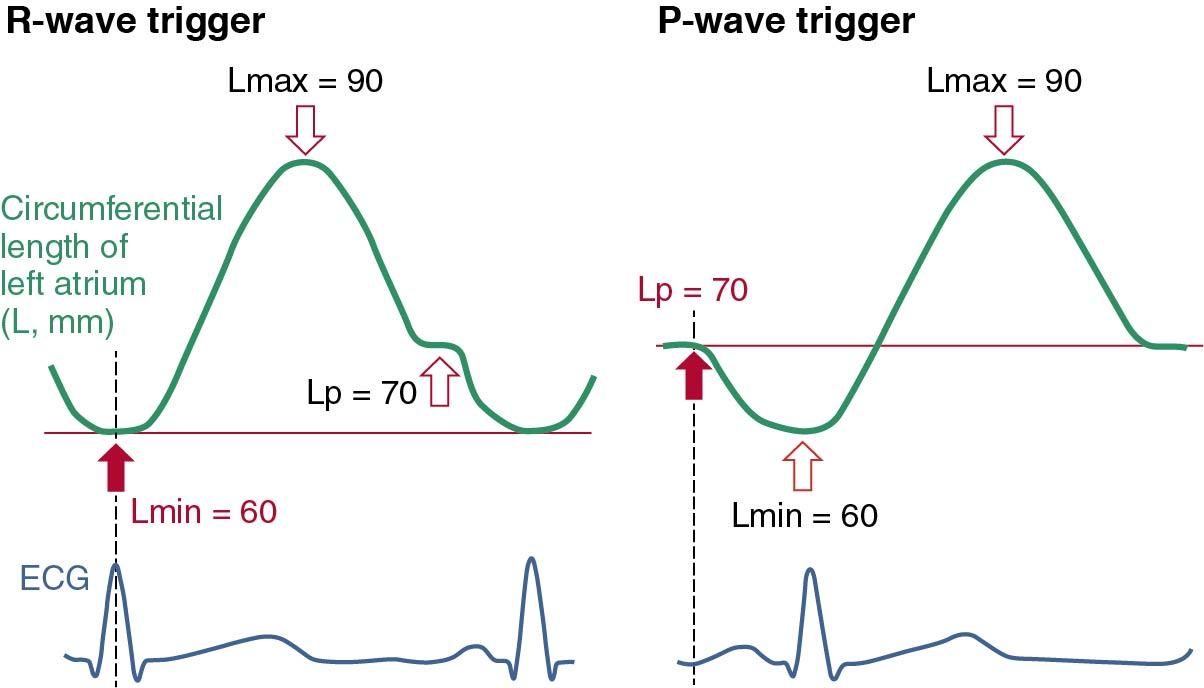
There have been a number of observational studies demonstrating a good correlation between LA strain and mean wedge pressure. LA strain can be used as a supplemental method to determine the presence or absence of diastolic dysfunction in patients with indeterminate diagnosis. Singh et al showed that LA strain significantly decreased among all stages of diastolic dysfunction, and abnormal LARS was significantly associated with cardiovascular endpoints after adjustment for clinical confounders. LA strain has also been used to diagnose new-onset HFpEF accurately in the outpatient setting. Taken together, these data suggest that LA strain may be useful in the diagnosis of diastolic dysfunction, accurate estimation of LVFP, and prognostic assessment. However, the cutoff value of LA strain to detect diastolic dysfunction is debatable. The mean value of LARS (∼40%) in healthy subjects is certainly well above this cutpoint because of atrial reserve. A LARS measurement of <25 % was proposed to assess the presence or absence of HFpEF in 378 subjects. A LARS cutoff of <18% has been proposed to differentiate normal LVFP from elevated LVFP ( Fig. 6.9 ).
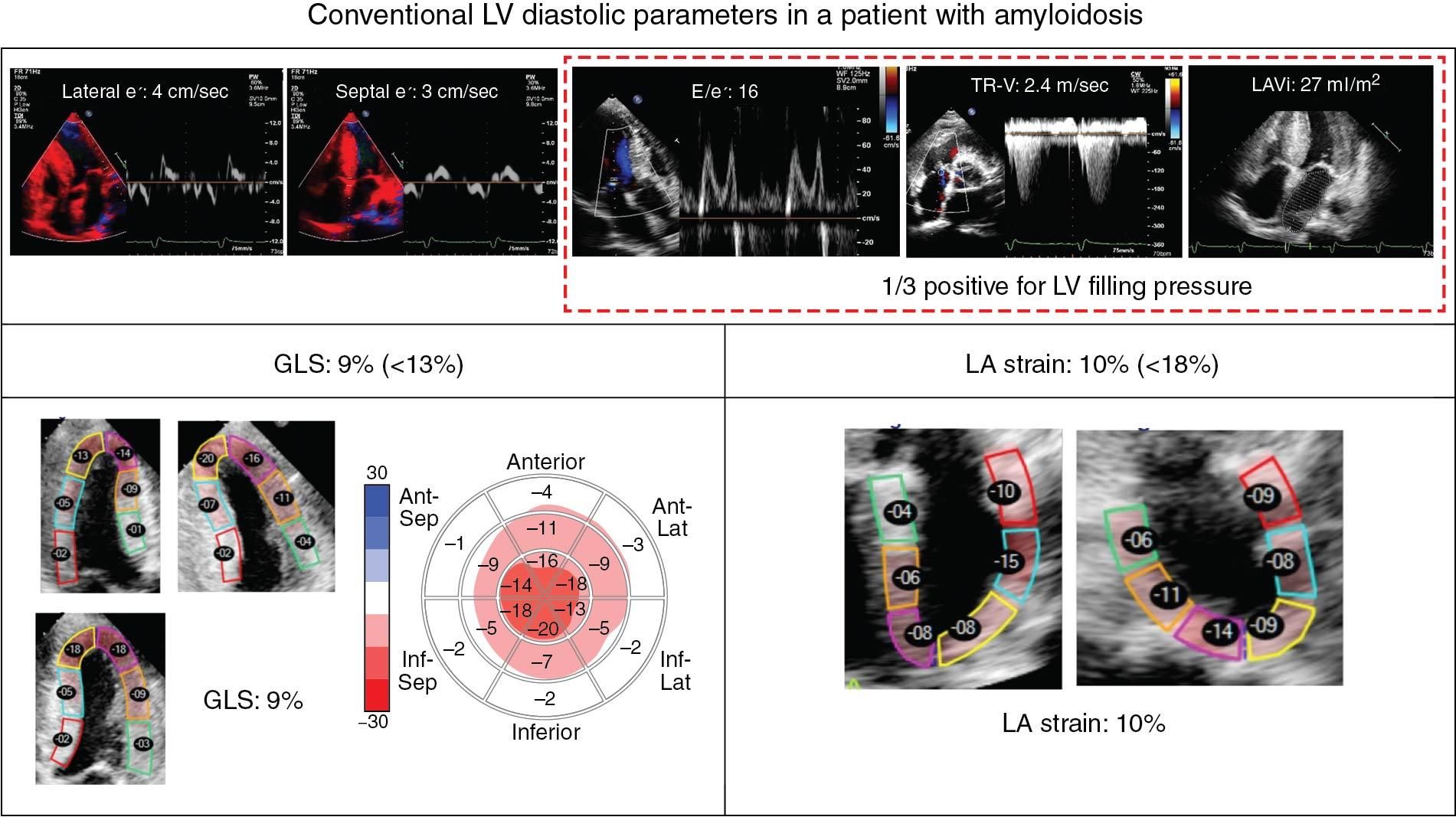
In patients with left-sided HF, longstanding elevation of RV afterload leads to RV dysfunction. Both RV abnormalities and pulmonary hypertension (PH) can be identified echocardiographically and are frequently seen in HF. Several studies have shown that RV longitudinal strain is a powerful independent predictor of cardiovascular events in left-sided HF with PH. However, because both left- and right-sided HF similarly lead to RV dysfunction, it is difficult to differentiate etiologies of RV dysfunction using only the echocardiogram. Thus, although RV strain has the potential to evaluate the presence of diastolic dysfunction, further studies are required to assess the clinical utility of this signal.
During a cardiac cycle, the helical arrangement of myofibers leads the left ventricle to rotate in opposite directions from the base to apex. Twist defines the base-to-apex gradient in the rotation angle along the longitudinal axis of the left ventricle ( Fig. 6.10 ). LV torsion and untwisting have important roles in LV ejection and filling; LV twist in a key contributor to the storage of potential energy at end systole, and the release of elastic recoil during early diastole assists ventricular suction. Nonetheless, the presence of torsion does not seem essential for the ventricle to function normally—patients with a total absence of the left pericardium have a lack of LV torsion while maintaining LVEF and regional myocardial function.
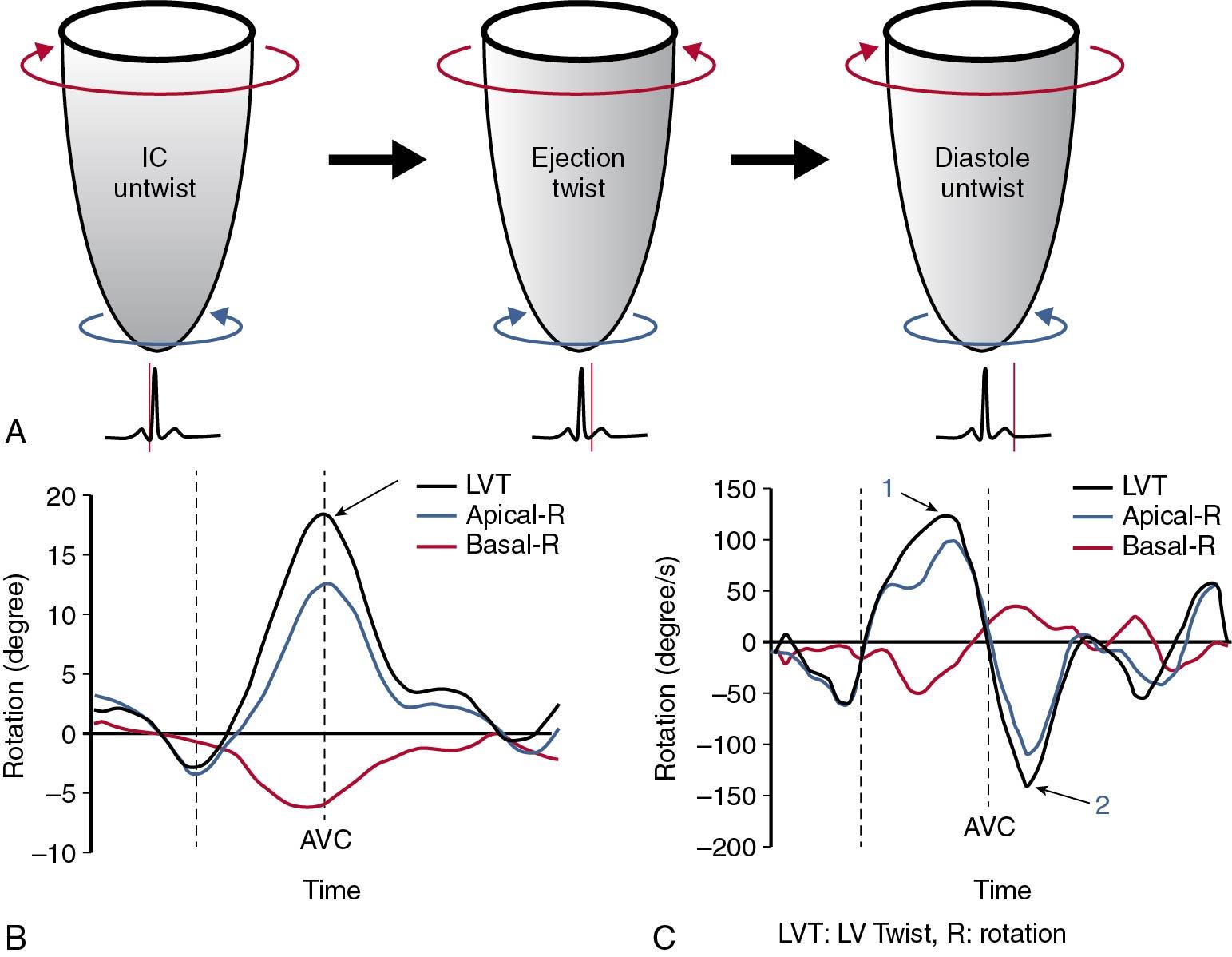
LV untwisting rate is one parameter that has gathered interest as a marker of LV suction. The timing of peak untwisting rate can be a valuable parameter in diagnosing diastolic dysfunction with normal LV volumes and LVEF. A delayed peak LV untwisting rate is often found in association with delayed LV relaxation. Because there are complexities of the measurements and difficulties in revealing the contribution of each of the underlying variables, further studies are required to clarify its role in the clinical setting.
Become a Clinical Tree membership for Full access and enjoy Unlimited articles
If you are a member. Log in here